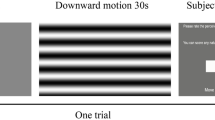Abstract
We studied amplitude of the wave N200 of the motion-onset VEP by varying the side length of a square stimulation field between 0.5 and 7 degrees. A significant increase in amplitude was obtained between 0.5 and 1 degree of side length in central stimulation and between 0.5 and 5 degrees in 10-degree peripheral stimulation. Variations of spatial frequency between 0.34 and 6.8 c/deg did not modify the amplitude size, ie, no tuning effect could be found. The results of simultaneous and separate stimulation of foveal and parafoveal regions support the observation that the stimulation field size is a minor influence. Features of motion-sensitive cortical neurons, such as those found in monkeys, could account for this behavior.
Similar content being viewed by others
References
MacKay DM, Rietveld WJ. Electroencephalogram potentials evoked by accelerated visual motion. Nature 1968; 217: 677–78.
Clarke PGH. Comparison of visual evoked potentials to stationary and to moving patterns. Exp Brain Res 1973; 18: 156–64.
Kulikowski JJ. Pattern and movement detection in man and rabbit: separation and comparison of occipital potentials. Vision Res 1978; 18: 183–89.
Yokoyama M, Matsunaga I, Yonekura Y, Shinzato K. The visual evoked response to moving pattern. Proc 16th Symposium, Morioka 1979; 207–14.
Müller R, Göpfert E. The influence of grating contrast on the human cortical potential visually evoked by motion. Acta Neurobiol Exp 1988; 48: 239–49.
Göpfert E, Schlykowa L, Müller R. Zur Topographie des Bewegungs-VEP am Menschen. Z EEG EMG 1988; 19: 14–20.
Markwardt F. Die Abhängigkeit visuell evozierter Potentiale auf Bewegungsreize von Geschwindigkeit, Raum- und Zeitfrequenz des Reizmusters. (Doctoral dissertation) Leipzig 1985.
Armington JC. The electroretinogram, the visual evoked potential, and the area-luminance relation. Vision Res 1968; 8: 264–76.
Bartl G, van Lith GHM, van Marie GW. Cortical potentials evoked by a TV pattern reversal stimulus with varying check sizes and stimulus field. Brit J Ophthalmol 1978; 62: 216–19.
Harter MR. Evoked cortical responses to checkerboard patterns: effect of check-size as a function of retinal eccentricity. Vision Res 1970; 10: 1365–76.
Groneberg A. Simultaneously recorded retinal and cortical potentials elicited by checkerboard stimuli. Doc Ophthalmol Proc Series 1980; 23: 255–62.
Roberts DK, Noda H. Effect of a parafoveal microlesion made with an argon laser on smooth pursuit eye movements of monkeys. Exp Neurol 1986; 93: 631–41.
Suzumara A. Studies on the visual acuity. The kinetic visual acuity for the visual objects of colored light. Ann Rep Environ Med Nagoya Univ 1964; 12: 53–60.
Campbell FW, Maffei L. Electrophysiological evidence for the existence of orientation and size detectors in the human visual system. J Physiol 1970; 207: 635–52.
Cannon MW Jr. Evoked potential contrast sensitivity in the parafovea: Spatial organization. Vision Res 1983; 23: 1441–49.
Tanaka K, Hikosaka K, Saito H, Yukie M, Fukuda Y, Iwai E. Analysis of local and wide-field movements in the superior temporal visual areas of the macaque monkey. J Neurosci 1986; 6: 134–44.
Author information
Authors and Affiliations
Rights and permissions
About this article
Cite this article
Göpfert, E., Müller, R. & Simon, E.M. The human motion onset VEP as a function of stimulation area for foveal and peripheral vision. Doc Ophthalmol 75, 165–173 (1990). https://doi.org/10.1007/BF00146552
Accepted:
Issue Date:
DOI: https://doi.org/10.1007/BF00146552




